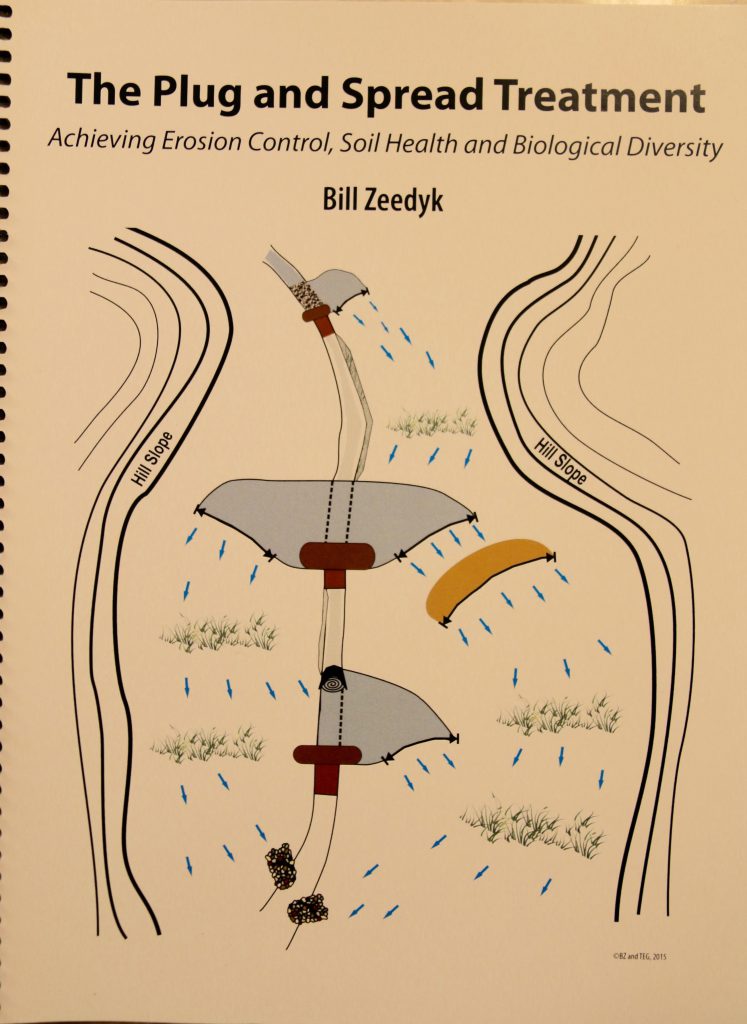Book Review - The Plug and Spread Treatment - Achieving Erosion Control, Soil Health and Biological Diversity

Book Review:
The Plug and Spread Treatment: Achieving Erosion Control, Soil Health and Biological Diversity
…By Bill Zeedyk

Habitat managers, who are struggling to control the gullies responsible for draining and drying rangelands throughout the desert southwest, have a useful new book written by Bill Zeedyk of Albuquerque, NM.
Bill retired after 35-years as a U.S. Forest Service wildlife biologist. For 25-years, he has focused on stream restoration, water harvesting and erosion control, completing more than 280 projects some of which are very extensive. We started working with him at Circle Ranch about 14-years ago and can attest that his treatments work.
Uncontrolled gullies are unfortunate features of every ranch I have seen in far-West Texas and New Mexico. Most were started by roads, which the old timers, lacking bulldozers, had to place in the bottoms of valleys. When wagon wheels nicked turf, small ruts formed. Over decades, many gullies down-cut and worked their way up hills and valleys. Today these can be miles long, yards deep—and some devour entire valleys.
Bill’s new book describes techniques that get water out of these gullies and divert it back onto valley meadows and hillsides where it can grow plants, which in turn protect and stabilize the soil. His methods are low-tech, inexpensive, holistic common sense. Most require only a small bulldozer like a D-4 and a few hours of work.
Bill calls his method “Plug and Spread”. Once gullys are plugged, their concentrated, rushing water is spread on grasslands as gentle sheet flows.
He shows how to build the plug using material from a shallow basin adjacent to the gully. Plugging the gully gathers, slows and pours water over a large area, back onto the normal drainage.
Some gullies can be drained on both sides; some only on one side; and some valleys have multiple gullies because they are home to several abandoned roadbeds. Bill provides example solutions for these situations and several others.
While it is vital to get the water to back up and spill out, it is equally important to prevent the development of new head cuts initiated by water back flowing into the gully. More than a dozen different structures designed to accomplish this are pictured.
The book includes excellent advice on integrating these structures over long distances. The design and placement of these structures is part of a planning process that according to Bill should precede the actual work.
In general, the “Plug and Spread” method works best:
- Where land adjacent to the gully is the same elevation or lower than the original land surface of the gully.
- Where streams that flow after heavy rains are now crossed by a gully, which redirects water flow.
- On old roadbeds, cattle and wild animal trails and abandoned drainage ditches.
This book is only 31 pages long but is chock full of step-by-step instructions,equipment lists, diagrams and photographs of actual projects. Again, these methods are low-tech, inexpensive, holistic common sense. And, from first-hand experience, I know they work. I highly recommend the book as a source of “outside the box” inspiration. Bill explores how to make the most of the restoring power of water instead of treating water as a liability to be disposed of as quickly as possible. I read extensively and have been unable to find any other person, agency or university that incorporates his methods in their practices or recommendations. Call this holistic management, permaculture, Keyline—or all three—no desert range manager’s toolbox is complete without these common sense approaches.
This practical guide is one of in a book series that Bill has written. These are available through the link below:
http://quiviracoalition.org/Publications/Publications_for_Purchase/
Here is a Plug and Spread project at Circle Ranch
